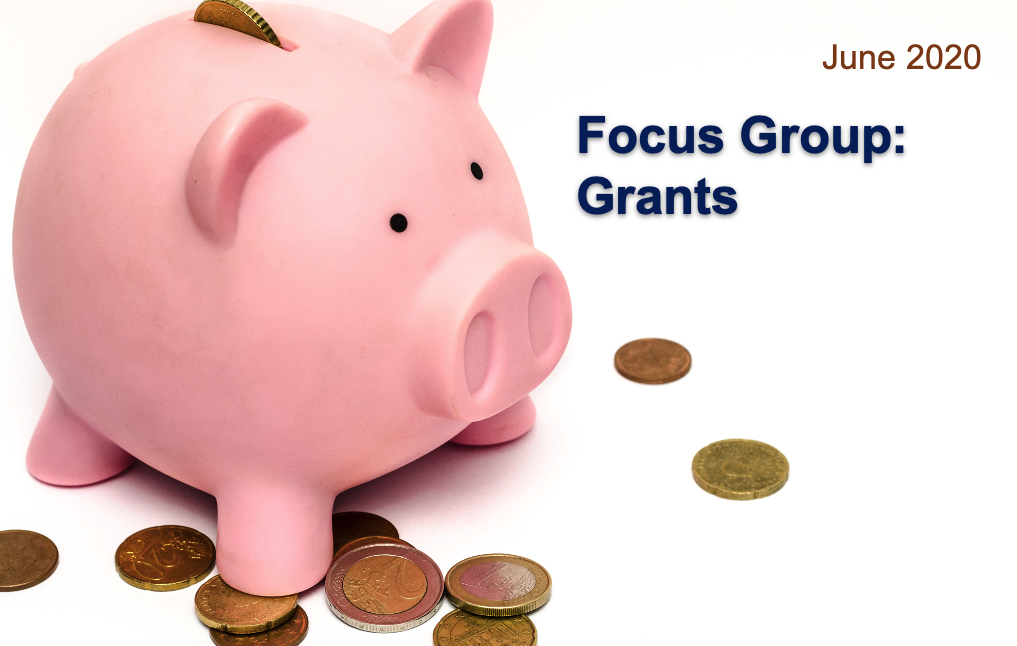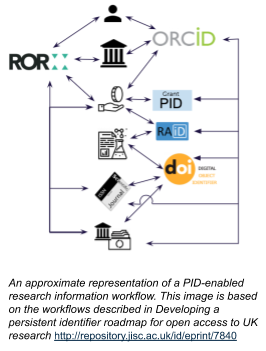This is a guest blog post written by Dr Fiona Murphy, MMC Consulting, https://orcid.org/0000-0003-1693-1240 and Dr Phill Jones, Double L Digital Consulting https://orcid.org/0000-0003-0525-6323.
Reference back to these posts about the wider project:
https://orcid.org/blog/2020/08/03/orcid-and-uk-national-pid-consortium

This — the first in a series of five blog posts being published this week — summarises the key findings of a recent focus group that explored how grant IDs could be integrated into the research ecosystem more effectively, as well as making recommendations for Jisc’s PID strategy.
The participants in the group included representatives from university research support managers, learned societies, infrastructure organisations, and UKRI.
Why do grants need PIDs?
Grant numbers have long been used by funders as an administrative tool to track awards, contracts, associated outputs, activities, people and organisations, but use of these internal identifiers isn’t scalable because they’re neither unique nor persistent.(1) Using persistent grant identifiers, and automating the connections between grants and everything that’s associated with them, could offer measurable benefits in a range of known problem areas. For instance, funding supports studentships, and provides training and career development opportunities, but we struggle to understand the career patterns and pathways of funded researchers as they move through academia and industry. It is also surprisingly difficult for researchers to show that they have complied with funder policies for their outputs, whether for FAIR data or Open Access, which makes it harder to incentivise openness or even just to reduce barriers to practising open scholarship.
Registering grants with Crossref
In 2019, Crossref launched a new service, enabling funders to register grants and related metadata with Crossref, and assigning DOIs to those grants in the process. Grant IDs are DOIs (digital object identifiers) and are registered with Crossref in the same way as other content types. This service aims to create a global registry of grants, with descriptive information including PIDs for investigators, organisations, projects, and connected grants.
Proposed activities
A functional workflow for grant IDs needs to have two major components: funders need to create and publish grant IDs along with associated grant information; and research administration and content platforms need to ingest that data, linking it to research activities and outputs. Funders need to know that the data will be used ‘downstream’ to justify their investment in grant IDs, and downstream users need to know that there is a critical mass of funding data available to justify the time and effort in upgrading their systems to make use of grant IDs. Throughout the process, opportunities for automation should be sought and acted upon wherever possible.

Group discussions
The grants focus group identified the need for an integrated strategy that goes beyond supporting compliance with Plan S to explore the long-term governance and sustainability of the entire PID infrastructure. Particularly with respect to grant IDs, effective systems have to be built and integrated to support all relevant workflows that are important to stakeholders, otherwise adoption will be stymied.
There were also discussions around driving the conversation on a global level, while maintaining a UK strategic focus, as well as the need to invest in education and outreach. The group had questions about how Crossref grant IDs work and felt they needed to know more before they could say if they were a functional solution. On the other hand, there was a clear view that funders could take a leadership role around a grant ID of some sort that could drive adoption of all PIDs.
Global impact
In terms of balancing UK strategic needs with the global needs of scholarship, the watchword was simplicity: the less UK-specific the interventions, the easier it will be to get buy-in from others. Vendors of RIM and CRIS systems support global communities, and may also be useful partners. By working with commercial vendors as well as non-commercial groups to incorporate standards for identifiers, it might be possible to normalise the use of grant IDs and drive penetration.
The need for education and outreach around grant IDs
Despite the fact that the people in the room were well-informed members and leaders of the PID community, there was a self-acknowledged lack of understanding of the nature of Crossref grant IDs. There was also a lack of understanding about the difference between a grant ID and a project ID (see our post on the project ID focus group later this week).
While there were no concrete objections to the Crossref grant ID system per se and in fact, Crossref was praised for making effort in this area, there was a reluctance to voice support for it purely out of a lack of knowledge of its functionality and metadata. However, during the session, the group collected a range of suggestions and questions, from querying how well it supports multi-funder grants and grant extensions to its potential integration with financial systems.
Driving adoption
To drive adoption, it is important to communicate a clear value proposition, preferably with working use cases or case studies.Some funders seem unclear about how the adoption of a grant ID would make it easier for them to collate and track the outputs of the work that they fund. Articulating the value propositions for funders — such as understanding the impact of the research and people whom they fund, and tracking collaborations and the efficacy of specific programmes over time — is key to the long-term success of this project.
The group agreed that funders occupy a very influential position in the research management and evaluation landscape. By adopting grant IDs, mandating their use, and working with partners such as research management systems vendors and publishers, the group felt that a national funder could set a powerful precedent and exert significant pressure on the ecosystem.
_____________________________________
1. For example, searching Europe PMC# for grant number 207467 returns results for grants from Wellcome Trust and the European Research Council, both of which have the same reference number.

One reply on “There’s A PID For That, Part 1: Grants”
Is there a distinction between PID and ID as used in this article, or are they both the same thing?
Are grant PIDs DOIs?